How To Do Sit-Ups For A Flat Tummy, Variations, Benefits
Tips, tricks, and variations of sit-ups to shed those extra pounds easily!

Image: Shutterstock
Sit-up exercises target the stubborn tummy fat. They can effectively tone your stomach and burn additional calories. Sit-ups work on the abdominals and other muscle groups like the rectus and transversus abdominis, obliquesi Muscles that run down the sides of your abdomen and assist in rotational movement and spinal protection. , and hip flexors. However, performing them properly is important to avoid injuries. Incorrect technique can lead to back injury and neck pain.
This article tells you how you can perform sit-ups the right way and the variations of this exercise form. We also discuss the benefits of including sit-ups in your fitness routine. Keep reading to know more.
 Workout Blueprint: Sit-Ups
Workout Blueprint: Sit-Ups- Frequency: 3-4 times per week
- Benefits: Tone and strengthen the core and improve posture.
- Equipment Needed: Yoga mat, dumbbell.
- Space Required: Small area
- Assistance Required: No
- Who Should Avoid: Anyone with a history of spinal issues, weak hip flexors, or lower back pain.
In This Article
How To Do Sit-Ups Correctly

Basic Sit-Ups Steps
- Lie down on a mat. Keep your legs hip-width apart, bend your knees, and place your feet flat on the floor. Keep your hands on the sides of your thighs (or at the back of your head), and push your lower back to the floor.
- Engage your core. Keep your neck in line with the spine, look diagonally up at the ceiling, and inhale.
- Exhale and use your core muscles for sitting up. As you do so, your hands will slide up from your thighs to your knees. Keep your shoulders relaxed.
- Inhale and slowly roll back down to the starting position. Make sure your lower back is lying flat on the mat.
- Again, exhale and sit up.
- Do 3 sets of 5 reps before moving on to 8, 12, and 15 reps.
 Quick Tip
Quick TipNow, let’s take a look at the guidelines to do sit-ups correctly to reduce the risk of injury.
3 Basic Guidelines To Do Sit-ups Correctly
- Always push your lower back to the floor so that it is completely on the ground. Place a rolled towel underneath if you cannot fully push the lower back to the floor.
- Do not strain your neck by tucking it in.
- Place your fingers behind your back and keep your arms open. Do not slouch.
 Quick Tip
Quick TipFollow these instructions while doing sit-ups to prevent pain in the neck or lower back. Achieving the proper form also helps target muscles apart from the abs. Here are all the muscles that sit-ups work on.
Which Muscles Do Sit-ups Work On?
Sit-ups work the rectus abdominisi The top layer of the muscle present in your abdomen, extending from your ribcage to your pelvic bone. , obliques, rectus femorisi A two-way acting muscle that crosses over the hip and knee joint and assists in extending the leg at the knee joint. , and the tensor fascia lataei Located near the hip, it helps in the movement of the knee and hip while providing them with the required stabilization. . These are the muscles that hold your spine and keep your body straight. They prevent collapsing or twisting of the spine, helping in the neck and hip movement.
Sit-ups work on almost the entire body, especially, when you do variations of the basic exercise. The following section lists the sit-up variations you can do to get a slimmer waist, stronger core, and better muscle endurance. Scroll down.
9 Sit-Up Exercise Variations To Get A Flat Tummy
1. Hands To Heels

Works On – Upper abs, lower abs, chest, quads, and shoulders
Steps
- Lie down on a mat. Keep your knees flexed, feet flat on the floor, and legs hip-width apart.
- Extend your hands above your head and keep them shoulder-width apart. Make sure your lower back is in a posterior tilt.
- Exhale and push your upper body up. Simultaneously, swing your hands from above your head to the side of your heels.
- Inhale and roll back down to the starting position.
- Do not tuck your chin. Keep your gaze diagonally up at the ceiling.
- Do 3 sets of 8 reps.
2. Straight Leg Sit-Ups

Works On – Lower abs and upper abs
Steps
- Lie down on the floor. Keep your legs hip-width apart, and hands above your head, and look up at the ceiling. This is the starting position.
- Exhale and pull your upper body up into a sitting position. Keep your hands extended above your head.
- Inhale and roll back down on the mat.
- Do 3 sets of 8 reps.
3. Butterfly Sit-Ups
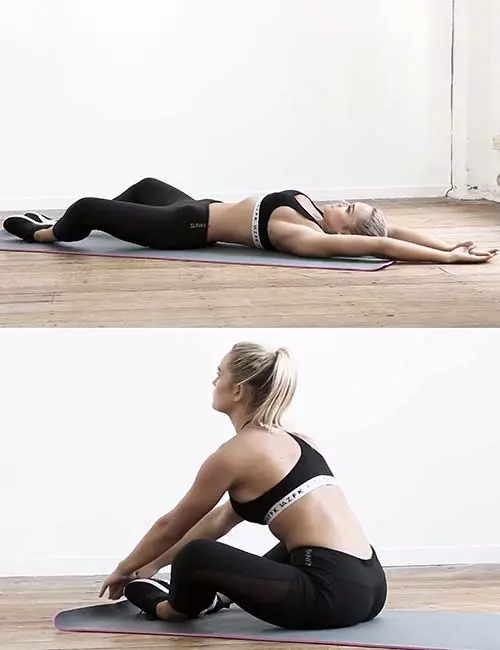
Works On – Lower abs, upper abs, rectus muscle, and adductors (inner thigh muscles)
Steps
- Sit on a mat. Keep your knees flexed and feet flat on the floor.
- Open your thighs and place the sole of your right foot against the sole of the left foot.
- Roll down slowly on the mat. Extend your hands above your head, and look up at the ceiling. This is the starting position.
- Exhale and pull your upper body up into a sitting position. Simultaneously, swing your hands from above your head to just beyond your toes.
- Inhale and slowly roll back down to the starting position.
- Do 3 sets of 8 reps.
4. V-Ups

Works On – Lower abs, upper abs, rectus muscle shoulders, quads, and hamstrings
Steps
- Lie down on a mat. Keep your legs together, hands extended above your head, and your spine in a posterior tilt.
- Lift both your legs and the upper body simultaneously. Try to touch your toes. Keep your gaze diagonally up at the ceiling.
- Inhale and roll back to the starting position.
- Do 3 sets of 8 reps.
5. Oblique V-Ups

Works On – Obliques, lower abs, upper abs, rectus muscle hip flexors, lats, and shoulders
Steps
- Lie down on your right side. Keep your right hand extended in front for support, your left hand extended towards the ceiling, legs together, knees slightly bent, and core engaged.
- Lift your legs and your upper body and touch your left leg with your left hand.
- Exhale and roll back to the starting position.
- Do this 10 times before switching sides.
- Do 3 sets of 10 reps on each side.
6. Weighted Sit-Ups

Works On – Lower abs, upper abs, rectus muscle, chest, and shoulders
Steps
- You can do this using a dumbbell or a plate.
- Sit down on a mat. Keep your legs hip-width apart, feet flat on the floor, spine straight, and shoulders relaxed.
- Hold the weight with both hands and lift it just above your head. Make sure your elbows are slightly bent.
- Roll back slowly. Make sure your spine is flat on the floor, and your hands are right above your head. This is the starting position.
- Exhale and sit up. Do not lift your legs off the floor. Keep your back straight. Do not tuck your chin. Look diagonally up at the ceiling.
- Inhale and go back to the starting position.
- Do 3 sets of 8 reps.
7. V-Up And Tuck
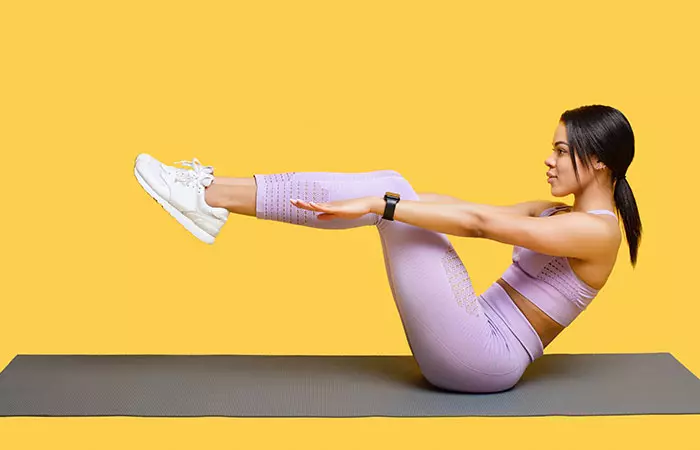
Works On – Lower abs, upper abs, middle abs, rectus muscle, quads, hamstrings, chest, and shoulders
Steps
- Lie down on the mat, hands overhead, legs extended, and lower back on the floor.
- Lift your legs off the floor. Keep them extended. This is the starting position.
- Engage your core, lift your upper body off the floor, bring your hands to the side, and tuck your knees in close to the chest. Exhale.
- Extend your legs, place your upper body back on the floor, and hands overhead.
- Do 3 sets of 8 reps.
8. Banana Twists

Works On – Obliques, lower abs, upper abs, rectus muscle, glutes, quads, and hamstrings.
Steps
- Lie down on the floor, legs together, and hands extended over the head.
- Lift your legs and hands off the floor. Engage your core muscles and squeeze your glutes. This is the starting position.
- Sit up. Bring your hands from above your head to near your knees, following an arched path.
- Simultaneously, flex your knees and do not drop your feet on the floor.
- Twist to the right and left without stopping. Exhale.
- Go back to the starting position. Inhale.
- Do 3 sets of 8 reps.
9. Weighted Crunch

Works On – Abdominal muscles, obliques, and lower back
Steps
- Lie on your back on an exercise mat.
- Bend your knees and place your feet flat on the ground, hip-width apart.
- Grab your weight and hold it close to your chest.
- Keep your spine in a neutral position, ribs down, and your pelvis should be slightly tucked.
- Engage your core and tuck the chin as if you were holding an egg under it.
- Curl your shoulders, and lift your upper body off the floor while clenching your abs. Hold the position for a few seconds or a minute.
- Then, slowly lower your torso to the starting position while maintaining tension on your abs.
- Do 2–3 sets of 10–15 repetitions.
These sit-ups will help improve core strength and whittle away the belly flab. Apart from sit-ups, you can also do crunches. But when it comes to crunches vs sit-ups, there are key differences in how they target your muscles and impact your workout. What are they? Find out in the next section.
Sit-Ups Vs. Crunches – What’s The Difference?
Sit-ups are different from crunches in the way they are performed and the muscles they activate. Crunches only work on the ab muscles. But sit-ups are a full-body workout that is great for physical activity and targets the core muscles, shoulders, chest, neck, thighs, and glutes.
Here’s a video to help you understand how sit-ups are different from crunches.
Apart from reducing belly fat, you also get to enjoy the following benefits by including sit-ups and their variations in your abs routine. So, what do sit-ups do? How do sit-ups benefit your health? Scroll down to know more!
Benefits Of Doing Sit-Ups
- Improve core strength
- Enhance hip flexor strength
- Increase flexibility
- Tone the ab area
- Improve posture
Tips On Sit-Ups
- Beginners should start with 3 sets of 8 reps and progress accordingly. To intensify your routine, increase the number of repetitions.
- The key to building core strength is the breathing technique. Take deep breaths and keep the pace slow. Concentrate on contracting the muscles and holding the position.
- Start with your feet 12-18 inches from your butt and continue doing curl-ups. If it feels intensive, increase the distance between your butt and feet. This new angle between your abdominal muscles and legs will take you through a few more reps.
- To avoid the pain caused by faster sit-up movement, do a less intense variation of the sit-up with the exercise ball. This can help reduce the strain on the lower back. Keep your lower back firmly in contact with the floor throughout the movement to avoid excessive strain.
- You can also add weights to intensify your sit-up and challenge yourself. Just grab a pair of dumbbells and hold them in your hands. Weights are best added in the Jackknife version of sit-ups.
Infographic: Top 5 Sit-Up Exercises For A Flat Tummy
Need a way to get rid of your stubborn tummy fat? Sit-ups are a great solution to tone your stomach, improve core strength, and burn extra calories. These target the abdominal muscles along with the obliques, rectus, transverse abdominis, and hip flexors. Check out the infographic below for the most effective sit-up exercises for a flat tummy.

Illustration: StyleCraze Design Team
Sit-up exercises are easy and satisfying to do. Just like planks, they are great for burning calories and dealing with the seemingly persistent abdominal fat. Sit-ups can be done anywhere, in the comfort of your home or at the gym. You just need a mat and comfortable clothes to get started. They aid bodybuilding, improve endurance, boost core strength, and tone your abdominal muscles. Sit-up exercises have many variations, and you can get started with the ones you feel most comfortable with. Progress gradually with the number of reps and the type of exercise for best results. Make sure that you are doing the exercise correctly as incorrect form can lead to injuries or muscle pains.
Frequently Asked Questions
How many sit-ups should a beginner do?
You can aim to begin with 10 reps.
What will 30 sit-ups a day do?
Doing 30 sit-ups a day can help you tone abdominal muscles when coupled with other exercises.
What exercise burns the most belly fat?
Exercises like burpees, mountain climbers, sprawls, and Russian twists work best for burning belly fat.
How many calories do 30 sit-ups burn?
You can burn approximately ½ calories per sit-up if you weigh heavier than 150 pounds. So, 30 sit-ups burn roughly 15 calories. However, if you weigh less, the calories burned will reduce. It also depends on the intensity of the workout.
Key Takeaways
- Sit-ups provide several benefits, including increased core and hip flexor strength, increased flexibility, ab area toning, and improved posture.
- Hands to heels, straight leg sit-ups, butterfly sit-ups, V-ups, oblique v-ups, weighted sit-ups, V-up and tuck, and banana twists are all variants of the basic exercise.
- However, it is critical to perform them correctly to avoid injuries, as improper technique can result in back ailments and neck pain.
Want to master the sit-up exercise? Watch this step-by-step tutorial and learn the proper technique for effective sit-ups. Start sculpting your core muscles today.
Read full bio of Rakesh Rathod
Read full bio of Ravi Teja Tadimalla
Read full bio of Payal Karnik






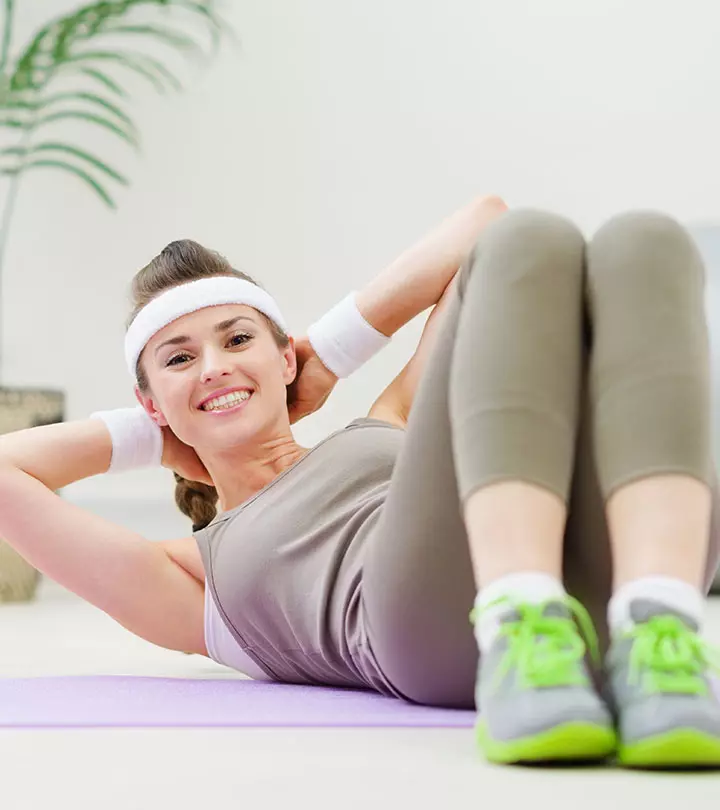



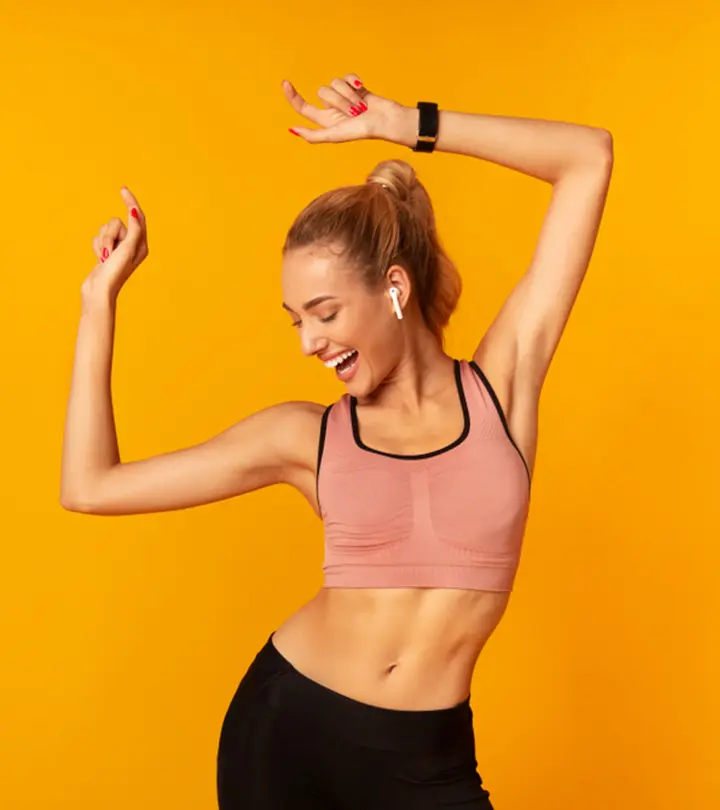



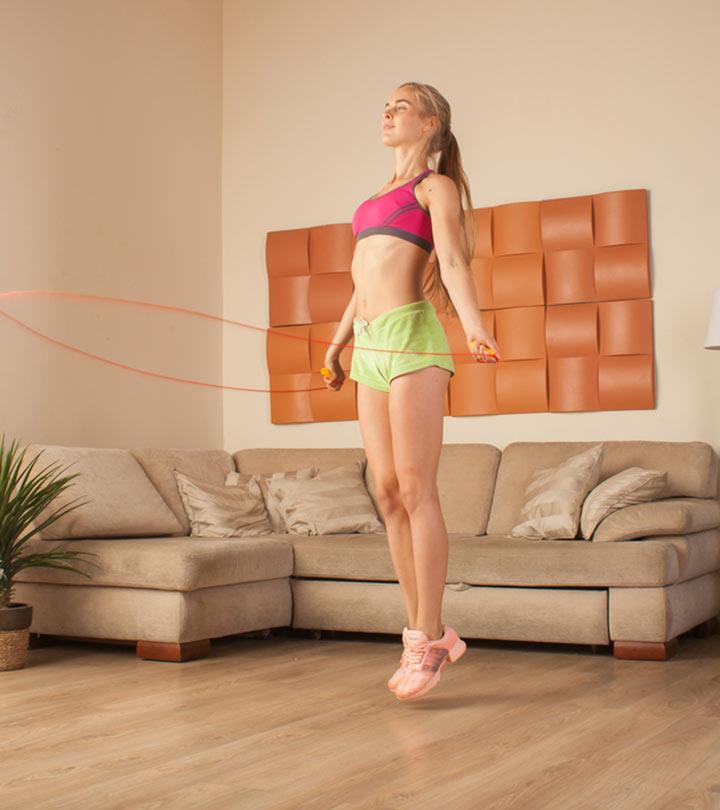








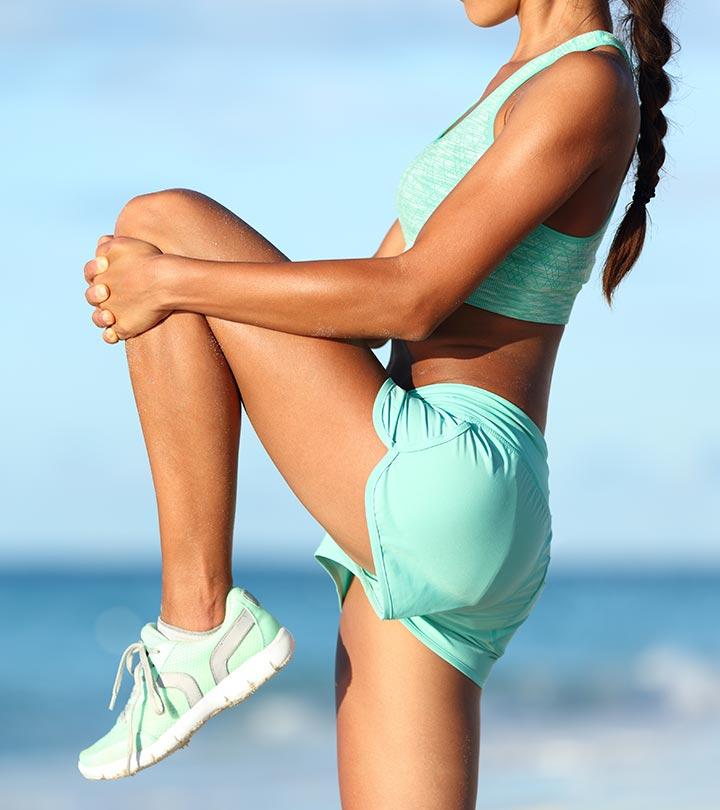

Community Experiences
Join the conversation and become a part of our empowering community! Share your stories, experiences, and insights to connect with other beauty, lifestyle, and health enthusiasts.